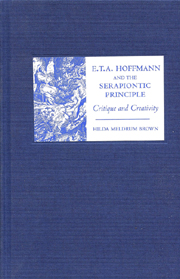Book contents
- Frontmatter
- Contents
- List of Illustrations
- Preface
- Acknowledgments
- List of Abbreviations
- Introduction: Approaches to the Serapiontic Principle
- Part 1
- 1 Overture: Jacques Callot
- 2 Der Einsiedler Serapion: The Formulation of a Principle
- 3 Der Dichter und der Komponist: Text and Music
- 4 Alte und neue Kirchenmusik
- 5 Prinzessin Brambilla: Callot Revisited
- 6 Epilogue: Des Vetters Eckfenster
- Part 2
- Conclusion
- Select Bibliography
- Index
2 - Der Einsiedler Serapion: The Formulation of a Principle
from Part 1
Published online by Cambridge University Press: 05 February 2013
- Frontmatter
- Contents
- List of Illustrations
- Preface
- Acknowledgments
- List of Abbreviations
- Introduction: Approaches to the Serapiontic Principle
- Part 1
- 1 Overture: Jacques Callot
- 2 Der Einsiedler Serapion: The Formulation of a Principle
- 3 Der Dichter und der Komponist: Text and Music
- 4 Alte und neue Kirchenmusik
- 5 Prinzessin Brambilla: Callot Revisited
- 6 Epilogue: Des Vetters Eckfenster
- Part 2
- Conclusion
- Select Bibliography
- Index
Summary
Introduction
Since his first attempts in the Fantasiestücke (the Callot preface and the “Kreisleriana”) to formulate his aesthetic ideas, Hoffmann's Romantic program had been developing apace alongside his growing experience as a writer. The need for an appropriate medium to present his ideas was therefore becoming urgent. Like his fellow Romantics who had a theoretical bent, Hoffmann could not use forms like manifestos or treatises, all of which had associations with Enlightenment systems. His need was for a flexible instrument that could accommodate his ever-expanding thoughts about the creative process and give scope for the expression of different shades of an argument — a requirement that may have reflected his cast of mind or, possibly, have been a by-product of his legal training. He was clearly committed to delivering his ideas in a form that was both lively and flexible. His preferred mode of presentation — an elaborate frame narrative — and the demands it makes on the reader somewhat resemble those created by a sophisticated modern literary text — and in elucidating any such text, as present literary criticism reveals, one can expect ambiguities rather than categorical statements.
The form of presentation employed for the exposition of the Serapiontic Principle in Die Serapionsbrüder is particularly complex. Here confusion has reigned about the relationship between the tale of the hermit, the narrator (Cyprian's) interpolations, the initial discussion of its meaning by members of the group, and Lothar's subsequent summarizing and definitive statement, which is based on gathering up all the strands of the previous discussion to form a “principle.”
- Type
- Chapter
- Information
- E. T. A. Hoffmann and the Serapiontic PrincipleCritique and Creativity, pp. 33 - 56Publisher: Boydell & BrewerPrint publication year: 2006



